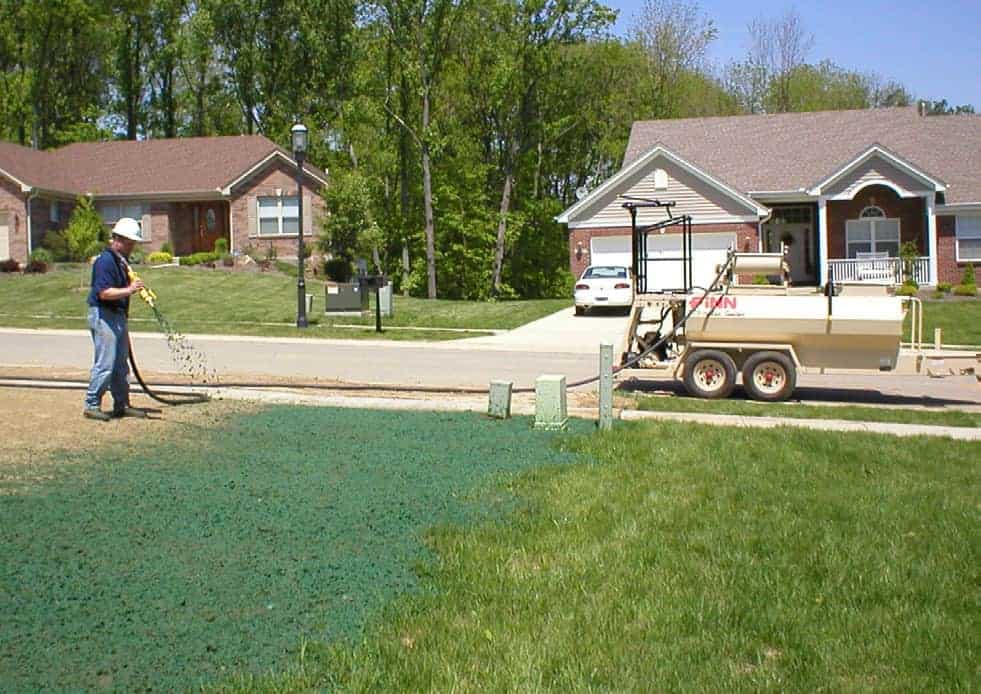
If you’ve ever driven past a construction site or a newly developed property and seen what looks like a greenish-blue coating sprayed across the ground, you’ve probably already witnessed hydroseeding in action. While it might look like someone just spray-painted the dirt, there’s actually a whole lot of science packed into that colorful mixture. In this post, we’ll break down exactly how hydroseeding works, why it’s so effective, and why more and more property owners are choosing this innovative method for establishing lush, healthy lawns.
What Is Hydroseeding?
At its core, hydroseeding is a planting process that involves spraying a slurry—a mix of seed, water, mulch, fertilizer, and sometimes tackifiers (binding agents)—onto the soil. This slurry creates an ideal environment for seed germination and early growth. It’s like giving your lawn a nutrient-packed smoothie to kickstart its development.
Hydroseeding is commonly used for residential lawns, commercial properties, roadways, parks, and even erosion-prone slopes. It’s quicker and often more cost-effective than traditional sodding, and it produces a more uniform, long-lasting result compared to dry seeding.
The Secret Sauce: What’s in the Slurry?
Here’s where the science kicks in. The hydroseeding mixture is carefully blended to maximize germination and minimize seed loss. Let’s take a closer look at each component:
-
Seed: The type of grass seed used depends on your climate, soil type, and desired lawn appearance. In Tilton, cool-season grasses like Kentucky bluegrass or fescue are popular choices.
-
Mulch: This acts as a protective blanket, keeping the soil moist and protecting the seeds from wind, birds, and sun.
-
Fertilizer: Gives the seeds an early boost, providing essential nutrients right where they’re needed.
-
Water: Starts the germination process and ensures the mixture sticks to the soil.
-
Tackifiers: Optional, but helpful on slopes or erosion-prone areas. They act like glue to keep everything in place until the grass takes root.
This carefully balanced combination creates a microenvironment that’s perfectly tailored for seed germination—something that’s tough to replicate with dry seeding.
How Hydroseeding Works
Once the slurry is mixed in a hydroseeder tank, it’s sprayed evenly across the soil surface using a high-pressure hose. Think of it like pressure washing in reverse—except instead of blasting grime off, you’re laying down a nutrient-rich layer to grow grass.
The mulch in the slurry forms a sort of blanket that retains moisture and temperature, creating a greenhouse-like effect for the seeds. This allows for more consistent germination, typically within 7 to 10 days, depending on the grass type and weather conditions.
Hydroseeding vs. Traditional Seeding vs. Sod
It’s natural to wonder how hydroseeding stacks up against other lawn-establishing methods.
-
Traditional seeding involves manually spreading dry seed and then watering and fertilizing separately. It’s less expensive upfront but takes more time, more effort, and often leads to patchy growth.
-
Sodding gives instant results, but it’s more expensive and not as adaptable to different soil types or conditions.
-
Hydroseeding strikes a balance. It’s faster and more uniform than traditional seeding and more affordable than sod—especially for larger areas.
Plus, hydroseeding allows for custom seed blends tailored to your specific property needs, which isn’t always an option with pre-grown sod.
Why Science Matters in Hydroseeding
It’s not just about spraying some seeds and hoping for the best. Proper hydroseeding takes an understanding of soil conditions, climate, seed biology, and nutrient cycles. Professionals offering Hydroseeding Services in Tilton take all these factors into account when preparing a job. They’ll test your soil’s pH, check for compacted areas, and select a seed blend that’s optimal for your yard’s sun exposure and drainage.
Then there’s timing—one of the most important parts of the process. Late spring and early fall are prime times for hydroseeding in New Hampshire. The soil is warm enough for germination, but the air is cool enough to prevent stress on young grass.
Long-Term Benefits of Hydroseeding
One of the biggest perks of hydroseeding is the health of the lawn that results from it. Because the seeds germinate right in your soil, the roots grow deep and adapt to the environment from day one. This means you’ll get:
-
A thicker, more even lawn
-
Fewer weeds, thanks to rapid grass growth crowding them out
-
Better resistance to disease and drought
-
Lower long-term maintenance
It’s a win-win: your lawn looks better and holds up better over time.
Who Should Consider Hydroseeding?
If you’re building a new home, renovating your landscape, or just tired of patchy grass and want a fresh start, hydroseeding might be the perfect fit. It’s also ideal for large areas where sod isn’t cost-effective and where traditional seeding would take too long to establish.
For those in New Hampshire looking for a reliable way to green up their property, Hydroseeding Services in Tilton offer both the scientific know-how and local expertise to get it done right.
Whether you’re a homeowner dreaming of a lush lawn or a contractor needing erosion control on a slope, understanding the science behind hydroseeding helps you make informed choices. It’s not just a shortcut—it’s a smarter way to grow grass.